1995 OLDSMOBILE SILHOUETTE traction control
[x] Cancel search: traction controlPage 193 of 390

Steering
Power Steering
If you lose power steering assist because the engine
stops or the system
is not functioning, you can steer but
it will take much more effort.
Steering Tips
Drividg tML Curves
It’s important to take curves at a reasonable speed.
A lot of the “driver lost control” accidents mentioned on
the news happen on curves. Here’s why:
Experienced driver or beginner, each
of us is subject to
the same laws
of physics when driving on curves. The
traction of the tires against the road surface makes
it
possible for the vehicle to change its path when you turn
the front wheels.
If there’s no traction, inertia will keep
the vehicle going in the same direction.
If you’ve ever
tried to steer a vehicle on wet ice, you’ll understand this. Suppose you’re
steering through a sharp curve. Then
you suddenly accelerate. Both control systems
--
steering and acceleration -- have to do their work where
the tires meet the road. Unless you have traction control
and the system
is on, adding the sudden acceleration can
demand too much of those places. You can lose control.
What should you do if this ever happens? Ease up
on the
accelerator pedal, steer the vehicle the way you want
it
to go, and slow down.
Speed limit signs near curves warn that you should
adjust your speed. Of course, the posted speeds are
based on
good weather and road conditions. Under less
favorable conditions you’ll want to go slower.
If you need to reduce your speed as you approach a
curve, do it before you enter the curve, while your front
wheels are straight ahead.
Try to adjust your speed
so you can “drive” through the
curve. Maintain a reasonable, steady speed. Wait to
accelerate
until you are out of the curve, and then
accelerate gently into the straightaway.
The traction you can get in a curve depends on
the
condition of your tires and the road surface, the angle
at which the curve
is banked, and your speed. While
you’re in a curve, speed is the one factor you can
control.
4-11
ProCarManuals.com
Page 196 of 390
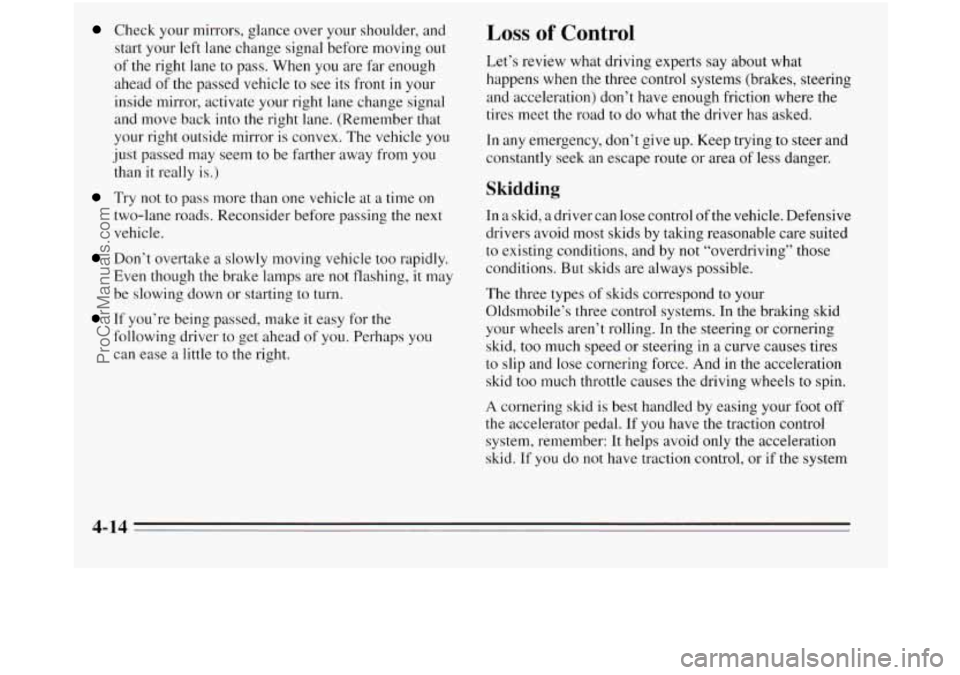
Check your mirrors, glance over your shoulder, and
start your left lane change signal before moving out
of the right lane to pass. When you are far enough
ahead
of the passed vehicle to see its front in your
inside mirror, activate your right lane change signal
and move back into the right lane. (Remember that
your right outside mirror is convex. The vehicle you
just passed may seem to be farther away from you
than it really
is.)
Try not to pass more than one vehicle at a time on
two-lane roads. Reconsider before passing the next
vehicle.
Don’t overtake a slowly moving vehicle too rapidly.
Even though the brake lamps are not flashing, it may
be slowing down or starting to turn.
If you’re being passed, make it easy for the
following driver
to get ahead of you. Perhaps you
can ease a little to the right.
Loss of Control
Let’s review what driving experts say about what
happens when the three control systems (brakes, steering
and acceleration) don’t have enough friction where the
tires meet the road to
do what the driver has asked.
In any emergency, don’t give
up. Keep trying to steer and
constantly seek an escape route or area of less danger.
Skidding
In a skid, a driver can lose control of the vehicle. Defensive
drivers avoid most skids by taking reasonable care suited
to existing conditions, and by not “overdriving” those
conditions. But skids are always possible.
The three types of skids correspond
to your
Oldsmobile’s three control systems. In the braking skid
your wheels aren’t rolling. In the steering or cornering
skid, too much speed or steering in a curve causes tires
to slip and lose cornering force. And in the acceleration
skid too much throttle causes the driving wheels to spin.
A cornering skid is best handled by easing your foot off
the accelerator pedal. If you have the traction control
system, remember: It helps avoid only the acceleration
skid. If
you do not have traction control, or if the system
A 1A
ProCarManuals.com
Page 197 of 390
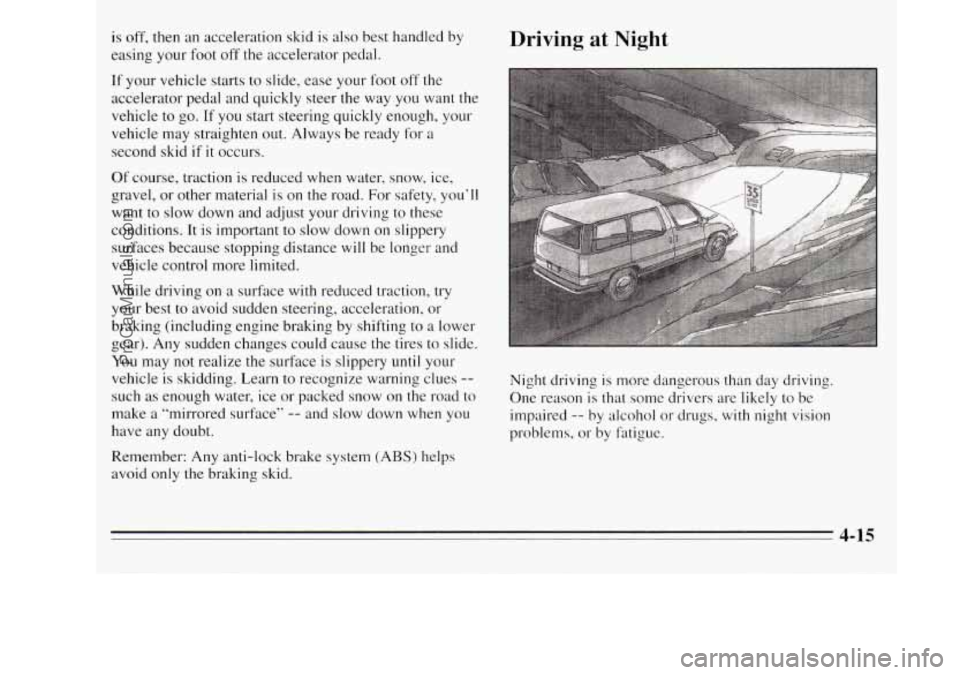
is off, then an acceleration skid is also best handled by
easing your foot
off the accelerator pedal.
Driving at Night
If your vehicle starts to slide, ease your foot off the
accelerator pedal and quickly steer the way you want the
vehicle to go. If you start steering quickly enough, your
vehicle may straighten out. Always be ready for a
second
skid if it occurs.
Of course, traction is reduced when water, snow, ice,
gravel, or other material
is on the road. For safety, you’ll
want to slow down and adjust your driving
to these
conditions. It is important to slow down on slippery
surfaces because stopping distance
will be longer and
vehicle control more limited.
While driving on
a surface with reduced traction, try
your best
to avoid sudden steering, acceleration, or
braking (including engine braking by shifting
to a lower
gear). Any sudden changes could cause the tires to slide.
You may not realize the surface is slippery until your
vehicle is skidding. Learn to recognize warning clues
--
such as enough water, ice or packed snow on the road to
make
a “mirrored surface” -- and slow down when you
have any doubt.
Remember: Any anti-lock brake system
(ABS) helps
avoid
only the braking skid. Night
driving
is more dangerous than day driving.
One reason is that some drivers are likely to be
impaired
-- by alcohol or drugs, with night vision
problems, or by fatigue.
4-15
ProCarManuals.com
Page 208 of 390
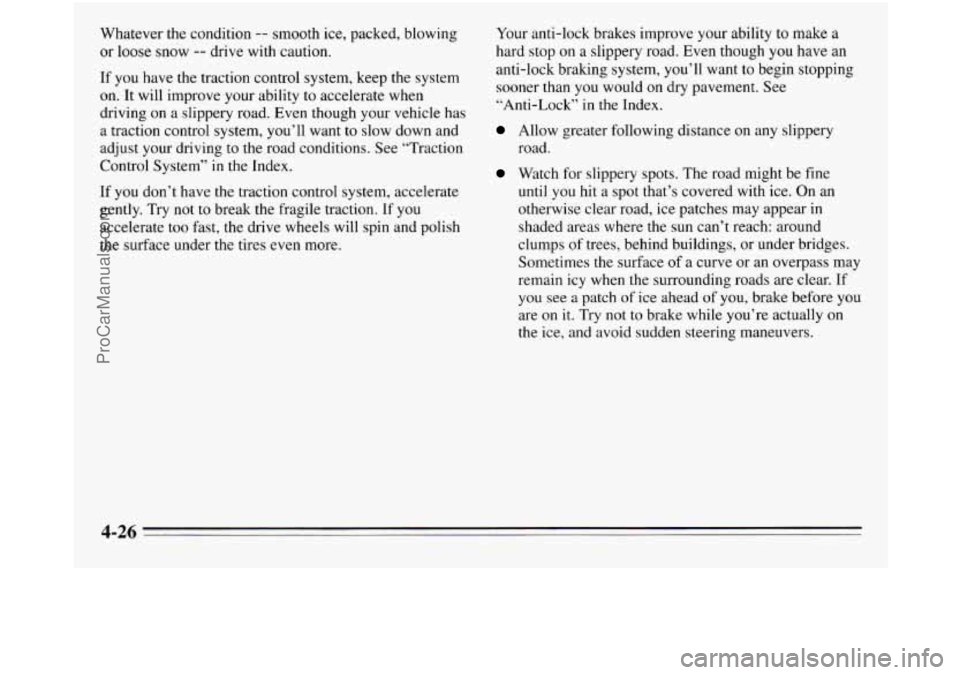
Whatever the condition -- smooth ice, packed, blowing
or loose snow -- drive with caution.
If you have the traction control system, keep the system
on. It will improve your ability to accelerate when
driving on a slippery road. Even though your vehicle has
a traction control system, you’ll want to slow down and
adjust your driving
to the road conditions. See “Traction
Control System”
in the Index.
If you don’t have the traction control system, accelerate
gently. Try not to break the fragile traction.
If you
accelerate too fast, the drive wheels will spin and polish
the surface under the tires even more. Your
anti-lock brakes improve your ability to make a
hard stop on a slippery road. Even though
you have an
anti-lock braking system, you’ll want to begin stopping
sooner than
you would on dry pavement. See
“Anti-Lock’ in the Index.
Allow greater following distance on any slippery
road.
Watch for slippery spots. The road might be fine
until you hit a spot that’s covered with ice. On an
otherwise clear road, ice patches may appear in
shaded areas where the sun can’t reach: around
clumps
of trees, behind buildings, or under bridges.
Sometimes the surface
of a curve or an overpass may
remain icy when the surrounding roads are clear.
If
you see a patch of ice ahead of you, brake before you
are on it. Try not to brake while you’re actually
on
the ice, and avoid sudden steering maneuvers.
4-26
ProCarManuals.com
Page 257 of 390
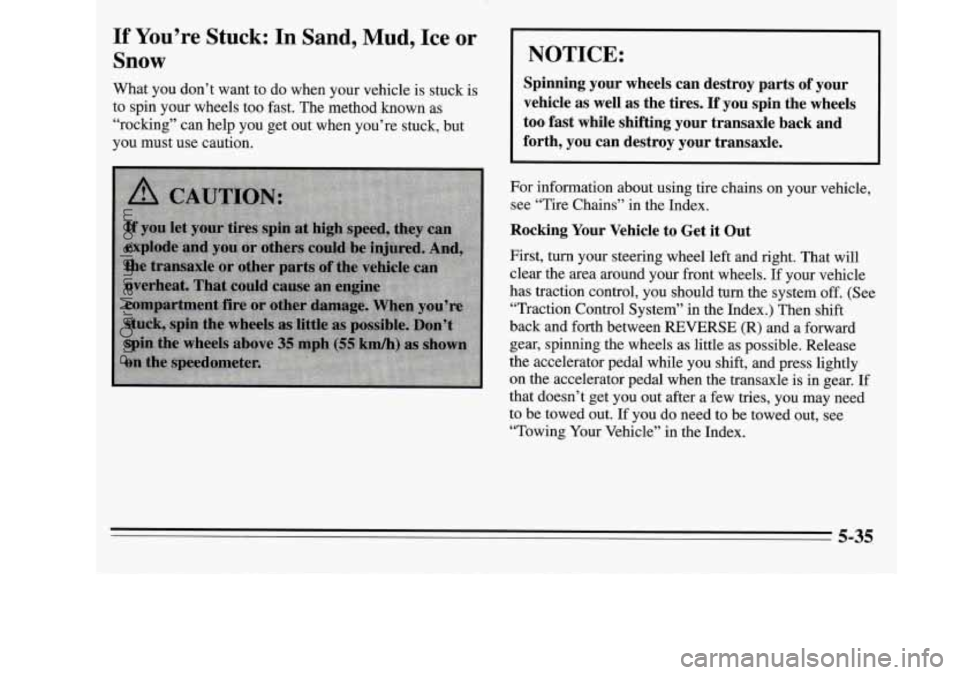
If You’re Stuck: In Sand, Mud, Ice or
Snow
What you don’t want to do when your vehicle is stuck is
to spin your wheels too fast. The method known as
“rocking” can help you get out when you’re stuck, but
you must use caution.
NOTICE:
Spinning your wheels can destroy parts of your
vehicle as well as the tires.
If you spin the wheels
too fast while shifting your transaxle back and
forth, you can destroy your transaxle.
For information about using tire chains on your vehicle,
see “Tire Chains’’ in the Index.
Rocking Your Vehicle to Get it Out
First, turn your steering wheel left and right. That will
clear the area around your front wheels.
I€ your vehicle
has traction control, you should turn the system off. (See
“Traction Control System” in the Index.) Then shift
back and forth between
REVERSE (R) and a forward
gear, spinning the wheels as little as possible. Release
the accelerator pedal while you shift, and press lightly
on the accelerator pedal when the transaxle is in gear. If
that doesn’t get you out after a few tries, you may need
to be towed out.
If you do need to be towed out, see
“Towing Your Vehicle” in the Index.
ProCarManuals.com
Page 299 of 390
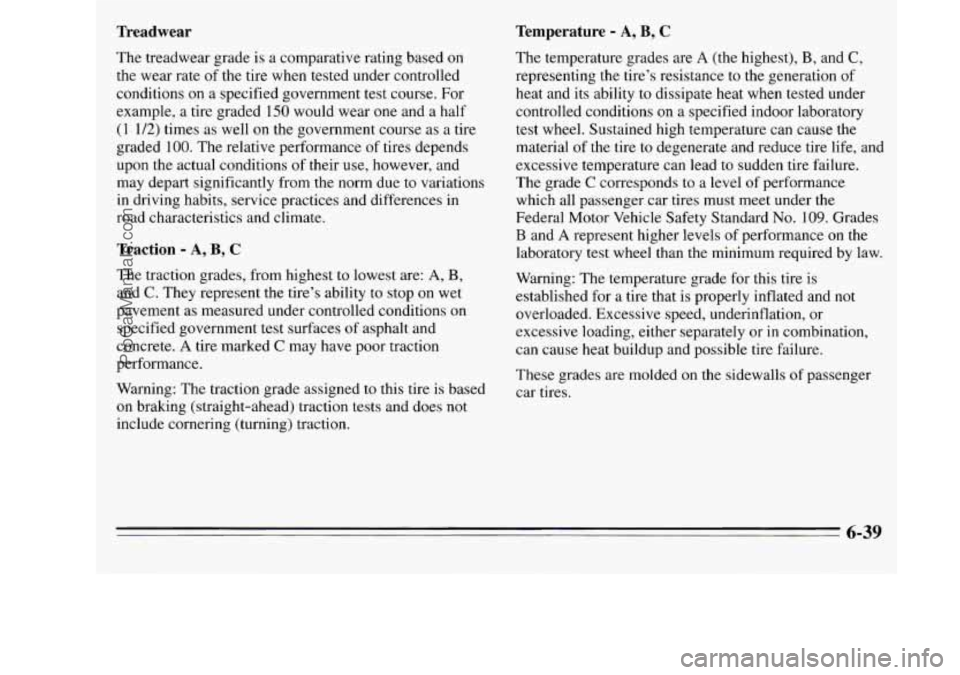
Treadwear Temperature - A, B, C
The temperature grades are A (the
highest), B, and C,
representing the tire’s resistance to the generation of
heat and its ability to dissipate heat when tested under
controlled conditions on a specified indoor laboratory
test wheel. Sustained high temperature can cause the
material of the tire to degenerate and reduce tire life, and
excessive temperature can lead to sudden tire failure.
The grade
C corresponds to a level of performance
which all passenger car tires must meet under the
Federal Motor Vehicle Safety Standard
No. 109. Grades
B and A represent higher levels of performance on the
laboratory test wheel than the minimum required by law.
The treadwear grade
is a comparative rating based on
the wear rate of the tire when tested under controlled
conditions on a specified government test course. For
example, a tire graded
150 would wear one and a half
(1 1/2) times as well on the government course as a tire
graded
100. The relative performance of tires depends
upon the actual conditions
of their use, however, and
may depart significantly from the norm due to variations
in driving habits, service practices and differences
in
road characteristics and climate.
Traction - A, B, C
The traction grades, from highest to lowest are: A, B,
and C. They represent the tire’s ability to stop on wet
pavement as measured under controlled conditions on
specified government test surfaces
of asphalt and
concrete.
A tire marked C may have poor traction
performance.
Warning: The traction grade assigned
to this tire is based
on braking (straight-ahead) traction tests and does not
include cornering (turning) traction. Warning:
The temperature grade for this tire is
established for a tire that
is properly inflated and not
overloaded. Excessive speed, underinflation, or
excessive loading, either separately or in combination,
can cause heat buildup and possible tire failure.
These grades are molded on the sidewalls
of passenger
car tires.
6-39
ProCarManuals.com
Page 380 of 390
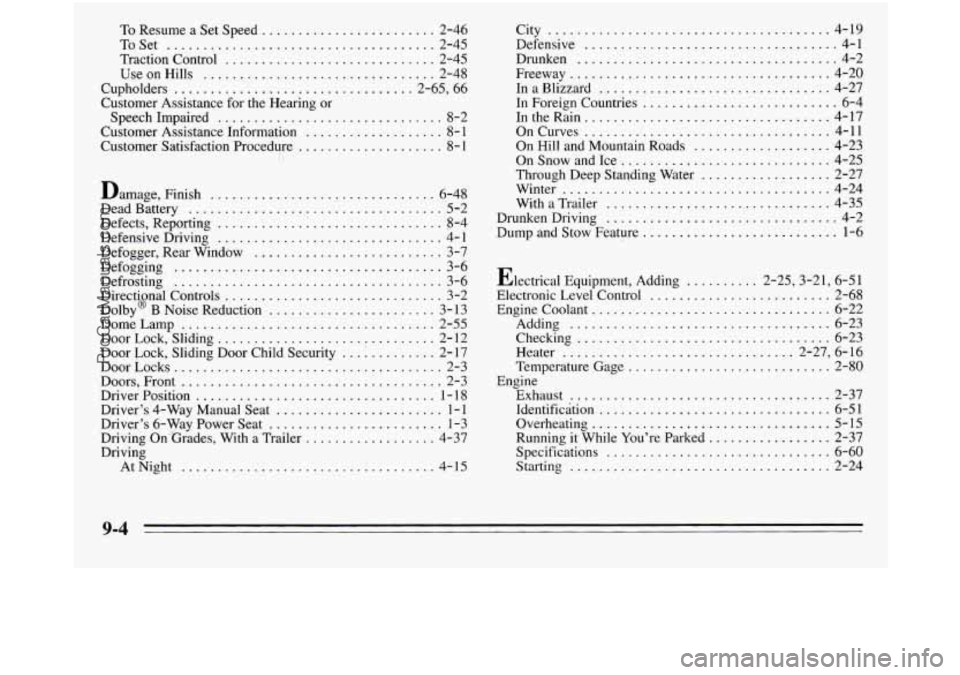
To Resume a Set Speed ........................ 2-46
ToSet
..................................... 2-45
Traction Control
............................. 2-45
UseonHills
................................ 2-48
Cupholders
................................. 2.65. 66
Customer Assistance for the Hearing or
SpeechImpaired
............................... 8-2
Customer Assistance Information
................... 8- 1
Customer Satisfaction Procedure .................... 8- 1
Damage. Finish ............................... 6-48
Dead Battery ................................... 5-2
Defects. Reporting
............ i .................. 8-4
Defensive Driving
............................... 4- 1
Defogging ..................................... 3-6
Defrosting
..................................... 3-6
Directional Controls
.............................. 3-2
Dolby@
B Noise Reduction ....................... 3- 13
Dome Lamp ................................... 2-55
Door Lock. Sliding .............................. 2- 12
Door Lock. Sliding Door Child Security ... ......... 2- 17
DoorLocks ..................................... 2-3
Doors. Front
.......................... I ......... 2-3
Driver Position
................................. 1 - 1 8
Driver’s 4-Way Manual Seat
....................... 1 - 1
Driver’s 6-Way Power Seat ......................... 1-3
Driving On..Grades. With a Trailer .................. 4-37
Driving
AtNight
................................... 4-15
Defogger. Rear Window .......................... 3-7 City
....................................... 4-19
Defensive
................................... 4-1
Drunken
.................................... 4-2
Freeway
.................................... 4-20
In a Blizzard
................................ 4-27
In Foreign Countries
........................... 6-4
In the Rain
.................................. 4-17
OnCurves .................................. 4-11
On Hill and Mountain Roads ................... 4-23
OnSnowandIce
............................. 4-25
Through Deep Standing Water
.................. 2-27
Winter
..................................... 4-24
With a Trailer
............................... 4-35
Drunken Driving
.......... ..................... 4-2
Dump and
Stow Feature ........................... 1-6
Electrical Equipment. Adding .......... 2.25. 3.21. 6-51
Electronic Level Control
......................... 2-68
Enginecoolant
................................. 6-22
Adding
.................................... 6-23
Checking ................................... 6-23
Heater
................................ 2.27. 6. 16
Temperature Gage
............................ 2-80
Exhaust
.................................... 2-37
Identification ................................ 6-51
Running it While You’re Parked
................. 2-37
Specifications
.. :’. ........................... 6-60
Starting
.................................... 2-24
Engine
Overheating
................................. 5-15
9-4
ProCarManuals.com
Page 382 of 390

......................................... Horn 2-39
Hydroplaning .................................. 4- 18 Key
Lock Cylinders
............................ 7-37
Key Reminder Warning
.......................... 2-23
Keys
.......................................... 2-1
&You’re Stuck
In Sand. Mud. Ice or Snow ......... 5-35
Ignition Key Positions
........................... 2-23
Ignition Switch
................................. 2-23
Illuminated Entry System
......................... 2-11
Inflator.
Air ................................... 2-63
Injector 3365 Fuse
.............................. 6-56
Inside Daymight Rearview
Mirror ................. 2-58
Brake System
............................... 7-39
Restraint Systems
............................ 7-39
Axle Boot and Sed ......................... 7-39
Throttle Linkage
............................. 7-39
Instrument Panel Cluster
......................... 2-72
Instrument Panel Intensity Control
................. 2-49
Instrument Panel. Cleaning
....................... 6-45
Integrated
Roof Antenna ......................... 3-23
Interior Lamps Control
........................... 2-55
Interior Lights Override Switch
.................... 2-56
Inspections
Exhaust Systems
............................. 7-39
Steering. Suspension and Front-Wheel-Drive
Instrumentpanel
............................... 2-70
Jack.
Tie .................................... 5-25
Jumpstarting
................................... 5-2 Lamps
...................................... 2-49
Lamps Control. Interior
.......................... 2-55
Lamps On Reminder
............................ 2-49
Lane Change Indicator
........................... 2-41
Larger Children. Safety Belt Use
................... 1-54
Latches. Side Window
........................... 2-39
Leaving
Your Vehicle ............................. 2-7
Leaving
Your Vehicle With the Engine Running ....... 2-35
Level Control. Electronic
......................... 2-68
Liftgate Ajar Warning Light
....................... 2-84
Liftgate Lock
.................................. 2-19
Liftgate. Raising
................................ 2-19
Lights Air Bag: Readiness
................. .... 1.27, 2.76 ......
Anti-LGck Brake System Warning ........... 2.78. 4.7
Brake System Warning ........................ 2-77
Liftgate Ajar Warning
......................... 2-84
Low Fuel Warning
........................... 2-85
Low Traction
............................ 2-80, 4-9
Power Sliding Door Warning
................... 2-84
Safety Belt Reminder
.................... 1-13, 2-76
Service Engine Soon
.......................... 2-81
TCS Warning ........................... 2.79, 4-9
Traction Control System Warning
........... 2-79, 4-9
9-6
ProCarManuals.com